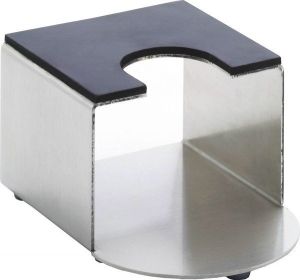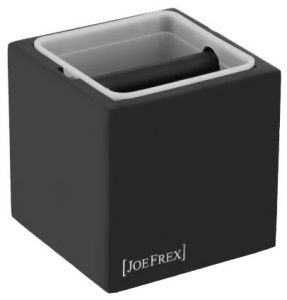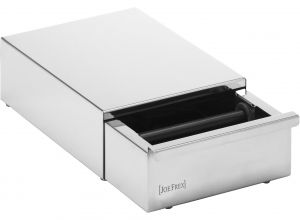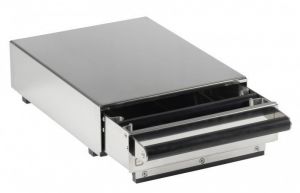
2-4 Workdays Article No. 2635
Article No. 2635

2-4 Workdays Article No. 2643
Article No. 2643

2-4 Workdays Article No. 2644
Article No. 2644

2-4 Workdays Article No. 9420
Article No. 9420

Unavailable Article No. 9028-L
Article No. 9028-L

Unavailable Article No. 9043
Article No. 9043

Unavailable Article No. 9076
Article No. 9076

Unavailable Article No. 9421
Article No. 9421
The perfect espresso
The espresso bean
Botanically, the coffee bean is a drupe, as it is surrounded by pulp, but this is removed. The diameter of the cells of the coffee bean is between 30 and 40 µm.
The espresso grinder
While the particle sizes of coffee grounds for a filter coffee are about 400 to 600 µm, a finer ground with a particle size of about 200 to 250 µm is used for an espresso. Laboratory practice study: Small parts, big taste: Particle size determination in foods
Thus, espresso produces fragments that are about five to six cells in size. There are two extraction modes:
Two extraction modes
In the process of coffee extraction, a distinction is made between the washout phase and the extraction phase.
1. the washout phase describes the process of washing out the ingredients from the cells damaged during grinding. Here, extraction proceeds very quickly, since the contents of cells can be easily washed out due to destroyed cell walls.
2. the extraction phase describes the process where the water penetrates into the intact cells of the five to six cell fragments. Therefore, extraction proceeds more slowly here.
If the coffee is finely ground, as in the case of espresso, the substances are extracted almost exclusively via the washout phase. If the beans are ground very coarsely for use in the French press and the water remains in contact with the fragments for minutes, the extraction phase plays a greater role.
Effect on the taste
The time of interaction between water and coffee fragment also determines which substances are dissolved. This is because substances that are poorly soluble in water are dissolved in very low, imperceptible quantities when washed out, whereas they are dissolved in a concentration that can be tasted when extracted.
The particle size therefore plays a decisive role for the taste. If the espresso is ground too coarsely, it can become sour; if it is ground too finely, it becomes bitter. Only when the size is right do you get a full-bodied taste.
The right particle size is important for a good espresso. The finer the espresso is ground, the longer the water lingers on the powder. This increases the contact time, and among other things, poorly soluble tannins go into the coffee, which are responsible for the bitter taste.
The particle size distribution
The correct particle size distribution also plays a role. If the particle size distribution is too broad, the coffee will taste sour and bitter.
The higher the quality of the grinder, the narrower the particle size distribution curve (see picture below). If espresso were made only from particles from the left part of the curve (where the very finely ground particles are), the coffee would be very bitter. The particles are too small, so the water has a high retention time due to the dense packing. This dissolves poorly soluble, bitter tannins, which would otherwise remain in the powder. Tannins bind to proteins and are responsible for the dry, dull feeling in the mouth of tea, wine and coffee. https://www.ncbi.nlm.nih.gov/pmc/articles/PMC6668809/
If an espresso were made only from the right part of the curve (where the coarsely ground particles are), it would be very acidic.

Particle size decreases after a few grinds because oils gum up the grinder. These oils then oxidize over time. This causes a rancid aftertaste. The coffee grinder should be cleaned regularly and properly so that it again achieves the desired degree of grinding and the oxidized oils are removed. Link to our cleaners.
We offer you the possibility to send us espresso powder ground by your grinder. We will then measure it photometrically and send you the result of the curve (see picture above).
The portafilter
The portafilter must be preheated, as well as the cups that are placed on the machine and the portafilter that is clamped unfilled.
Fill the portafilter correctly
Use the leveler clockwise
The leveler is used before tamping to ensure that the espresso grounds are evenly distributed. It can then be tamped to create an even layer. Channeling means that instead of flowing through the entire puck, the water only flows through a thin spot (usually the rim) in the espresso grounds and it over-extracts at that spot. The espresso then tastes unbalanced. This channeling is prevented by the even distribution, and thus the espresso has a perfect crema.
On the Internet, you can find curious instructions on how to use a leveler. However, not all roads lead to Rome here, but there is only one method of optimally distributing the espresso grounds. To do this, the leveler is placed loosely on the espresso grounds. Then it is accelerated clockwise without pressure and released. Then the tamper can be used. You can find levelers here.
Correct tamping
To tamp correctly, place the portafilter on a stable edge and place the tamper straight on the freshly leveled flour. Then use 15 kg of pressure to press the espresso grounds firmly. It takes a little practice to find the right pressure. A body scale can help with this. You can only build up this pressure when you put the portafilter on. You can find a selection of tampers here.
Steady clamping of the portafilter
The importance of clamping is often underestimated. In cafés, you can always observe how the barista wants to quickly clamp the portafilter in a hectic rush. He doesn't hit the tensioner right away and hits somewhere on the machine. In doing so, he ruins the leveling and possibly the tamping, thus enabling channeling.
So we take the rest we need for precision and clamp the portafilter slowly, without moving the espresso grounds.
Proper overbrewing
Optimal overbrewing involves flowing 7 grams of coffee through 30 ml of water at about 10 bars in about 25 seconds.
Most espresso grinders are designed to stop grinding after 7g.
The pumps of portafilter machines can generate pressures of up to 20 bar. A nozzle is then usually installed above the portafilter to regulate the pressure. You can see this when you run water through without a portafilter. Because the water then does not shoot out with 20 bar and burns the operator, but it runs out slowly. This control mechanism then also provides the required 10 bar.
Now there are two types of portafilter machines. With one, you press a button, then 30 ml flows out in 25 seconds. With the other, you operate a lever and can thus determine the pressure and flow time yourself. If you pull the lever down fully, you have the highest pressure, if you pull it down less, you have less pressure. Usually, however, such machines are set so that you have to pull the lever all the way down for 25 seconds.
If you look on the Internet, you will often find contrary or incorrectly formulated claims. Therefore, we took a closer look. The study Analyzing extraction uniformity from porous coffee beds using mathematical modeling and computational fluid dynamics approaches from 2019 shows that coffee extraction behaves according to the Darcy equation (the Forchmann extension of the equation is irrelevant for this), which is a conversion of the Karman-Kozeny equation. This equation describes the flow rate of espresso through the portafilter, which is inversely proportional to the volume-specific surface area of the powder. Thus, the smaller the surface area (i.e., the coarser the coffee is ground), the faster the flow rate.
Study: https://journals.plos.org/plosone/article?id=10.1371/journal.pone.0219906












